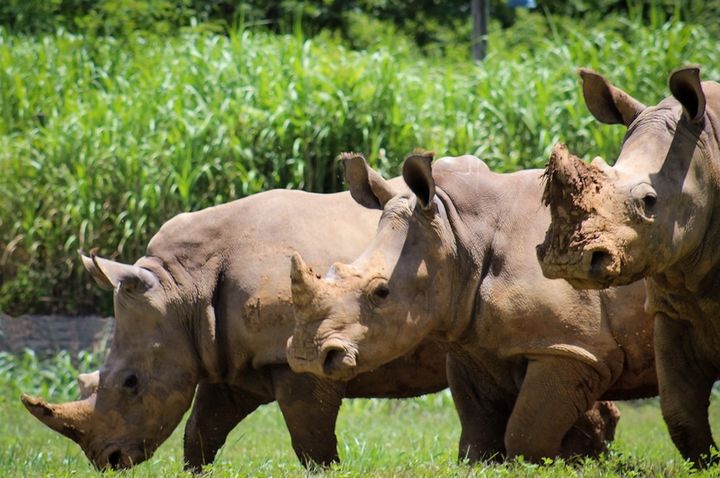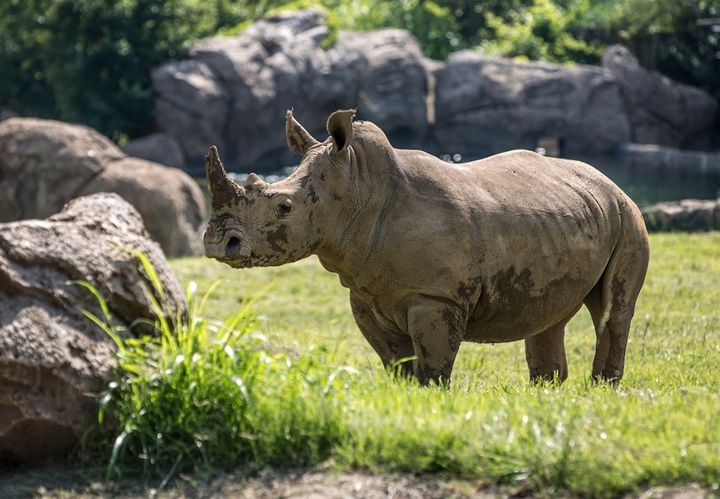
Three happy rhinos at Nashville Zoo
Part 3: The Future for Nashville Zoo’s Rhino Crash
Last August, the sight of four white rhinos enjoying their first summer at Nashville Zoo was full of promise and wonder. However, hearing the ambient slam, clank and pound of heavy machinery from above the rhino exhibit was another matter. The metallic discharges were enough to make a human, fresh from the latest news of gun massacres, skittish. Yet, the rhinos seemed to meet these sounds unflinchingly – or should I say, with the slightest swivel of their rotating ears.
The zoo is quite aware of the stressful sounds, not to mention the unavoidable sounds of the zoo’s location, which is near enough to train tracks and a major airport to draw a high degree of noise pollution. Stress from sounds is something they monitor closely among the animals.
It was among the early concerns zoo managers had for the girls - Modwani, Norma, Kacie and Nandi. They would have to transition from a sub-equatorial grassland, where the wind carries important news on birdsong and dung scent, to a northern temperate zone where irrelevant facts clamber in on rumbling train cars, blaring locomotive horns, roaring jets, and the cries of humans overhead, enjoying a zip line.
But our young white rhinos seem to take it all in stride. As far as intrusive sounds are concerned, the girls seem most responsive to the loud and far-flung whooping call of the gibbons. They had some shyness early on, but not from sounds.They were spooked by sudden shadows streaking across their grazing field, cast by the zip line overhead.
On the up side, the sound of heavy machinery bodes well for the young rhinos’ future. The zoo’s ongoing construction projects include a new facility for the soon-to-arrive bull rhino.
As an AZA-accredited enterprise, Nashville Zoo houses the four female rhinos under condition that they participate in a Species Survival Plan (SSP), overseen by the AZA (Association of Zoos and Aquariums). For their role in the SSP, Modwani, Kacie, Norma and Nandi will someday begin breeding. In part, the opportunity to breed and nurture young supports the health and wellbeing of the animal. From a larger perspective, breeding helps build up the American “herd,” a back-up rhino population that could re-start the species should the animal go extinct elsewhere.
But for these rhinos, breeding also means venturing into a risky dance with a mate.
Rhino mating: Enter the WWE
While white rhinos are generally gentle creatures, males can get testy in mating season. On the wrong day, an aggressive bull rhino can attack, rape, and gore a demurring female rhino when he wants to mate. Not to worry, friends of white rhinos. The worst of this behavior is most common among black rhinos and the very rare Sumatran rhino. It is thought that Samia, the female black rhino Anna Merz raised, released, and documented in her book Rhino at the Brink of Extinction, was driven to her death, along with her female calf, by an aggressive male rhino.
But even the most benign rhino mating behavior can appear quite rough to human eyes, and with horns on board, accidents can happen. Fortunately, the male slated to join the Nashville Zoo herd, once the construction of his residence is complete, comes AZA-vetted. Nashville Zoo’s lead rhino keeper, Jason Faessler reports that the bull coming to Nashville is known to have a good temperament. That’s half the battle.
Still, the introduction of this male to our rhino crash will be a gradual, all-eyes-on process, as Faessler calls it, involving all five Nashville Zoo rhino keepers: Faessler, Amelia Davis, Jennifer Wu, Nikole Edmunds, and Jonathon Hankins.
“Once he’s out of quarantine, we’ll start intros,” Faessler says. “We’ve all got rhino experience. We know the behavior, the body language.”
Nashville Zoo’s rhino keeper team can afford to be encouraged by their successes so far in introducing the four white rhino females to their new home together.
“We had eyes on them at all times until we felt they were acclimated and comfortable. We had some air horns and hoses - just in case.”
Air horns and hoses are also the back-up method of choice in breaking up an introduction between bull and cow that grows too aggressive. While vigilant veterinarians can ensure proper biological timing for the introduction, the process of a successful mating relies on observers knowing what to look for. Horn duels are common, and rhinos can approach varying levels of danger in the course of an ultimately productive interaction. In other words, you can’t stop things too soon, but you can’t wait until it’s too late.
Of dogfights and things
As the owner of dogs that will explode suddenly into a full out brawl, I’ve spent much time with skilled dog trainers like Todd “The Doggie Lama” Vehring and Nikki Ivey (Dogspeak 101), who taught me to spot the fine line between heightened tension and murderous aggression. I have learned that some wild aggression is more dangerous than other. But distinctions are difficult to spot in the heat of real time.
Perhaps erroneously, I draw from my unsettling experiences with dogfights, to wrap my head around the horror stories of black rhino aggression during mating. In a recent workshop on dog aggression, Ivey said dogs fight to work off tensions far more often than to destroy each other. Attacks to the head and neck are common and not generally kill moves. Yet, none of this wisdom is comforting when the fight is on.
As in Nikki Ivey’s workshop, the Rhino Husbandry Manual, put together by members of the AZA and the International Rhino Foundation, points to several stages of aggression. From where a 100 - 300 pound human might be standing, two tons of rhino in any of these stages could seem foreboding. The manual says that most of the confrontations are not emergencies requiring the keepers to intercede. Scratches and cuts from horn jabs can even be expected.
If you were thinking that rhino horn is a vestigial ornament, it is not. Rhinos use their horns as an all-utility appendage with finesse and expertise. In fact, while visiting Nashville Zoo’s rhinos, I observed the horn being used as a communication tool. One female had apparently chosen to eat from the wrong grassy food pile. The food’s “rightful owner” straightened things out with a quick, expert horn jab to the rump. The food thief jumped off and away from that pile post haste, message received.
While most worries about damage and aggression in mating focus on worst-case scenarios, and we have already seen our rhinos have great temperaments, the breeding process is still a considerable undertaking.

A rhino post-wallow
Leaving home - the risks of pre-zoo life
Some animal advocates look at a zoo exhibit and quickly point out that in the wild these rhinos, now confined to 3.5 acres, may have ranged over many miles. This is true. And rhinos will range even farther in drought – not so much for the joy of travel, but for the joy of eating, drinking, and mud wallowing.
Though rhinos have been resilient in the face of drought, pressure on water supplies increases with continued human expansion. Rhino travel routes are bordered by – and sometimes fragmented by – farms and roads. White Rhinos who can’t resist delicious ground crops in their path often suffer retributive killing by farmers.
Conservation and environmental forces in southern Africa invest heavily in efforts to prevent these animal deaths – prohibitive laws, fences, even compensation to farmers for their losses. But many ranches are huge, according to Nashville Zoo CEO Rick Schwartz. He recently visited some large ranches while in South Africa and found their vastness daunting. In addition, wildlife refuges can run for hundreds of miles and border or even cross national boundaries. So fencing is not a viable solution, especially when poachers cut holes in the fences.
We want to think of large animals roaming in uncharted habitats, but the realities of the rhinos’ home habitat may already have left that conceit behind. What may look like untouched wilderness to a tourist is most likely a park with poachers operating within it, and the “wild” animals wear markings or tracking collars that rangers know on sight.
So how did our four rhinos fit into this picture when the decision was made that they should leave? What was life like for them, and what drove their refugee journey?
The fourth and final part of this series takes a look at the troublesome realities around rhinos that must leave their homeland to take up life in a zoo.
